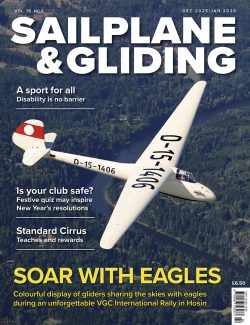Sign up for a new subscription for S&G, pay by Direct Debit and get 50% off your first year’s subscription.
Subscribe Subscriber LoginCurrent Issue
Dec-Jan 2026

Discover a timeless classic of soaring, and why disability is no barrier to the sky in the Dec/Jan issue of S&G. You can also learn why Hosin was an outstanding venue for the VGC International Rally and complete a festive safety quiz that may inspire New Year’s resolutions.
The Standard Cirrus is a timeless classic of soaring – beautifully simple, impressively capable, and still loved more than 50 years after its first flight. Designed by Klaus Holighaus and introduced in 1969, the Std Cirrus became the foundation for Schempp-Hirth’s modern glider lineage. Owners enjoy straightforward maintenance, excellent parts support, and a passionate global community that keeps these aircraft flying beautifully. Whether in club soaring, vintage competitions, or leisurely cross-country adventures, owners say that the Std Cirrus offers an engaging, responsive flight experience with a charm that modern gliders can’t quite replicate.
When Mark James arrived at Sutton Bank for an introductory trial flight, instructors were concerned to notice he has no right hand. After a short discussion around what he could and could not do, he was given the green light to fly. Mark committed to further flights and slowly but surely his confidence grew as he spent more time in the air controlling the glider with his right hook. The support of local and visiting instructors, and time spent training in the simulator, led to Mark being sent solo. Mark says that what his experiences have taught him is that many apparent disabilities can be overcome in flying with the support of others, determination to succeed, testing one’s capabilities and practice. He is confident that disability is no barrier to flying and is now working towards flying single-seaters.
The 2025 VGC International Rally at Hosin proved to be a standout event, delivering superb organisation, spirited flying and warm hospitality. Thanks to Vaclav Kysilka’s initiative, VGC pilots enjoyed a week of smooth operations, lively social events and memorable soaring – from aerobatic displays and international evening festivities to stunning cross-country flights in classic gliders. Despite mixed weather, the enthusiasm never dipped, culminating in a lively closing day that perfectly captured the energy and camaraderie of this unforgettable rally.
Gliding clubs take safety very seriously: they have some great ways of managing risks and often work hard on further improvements. However, there’s always more to do and there are things that could be done better. The BGA Safety Team has put together a festive quiz to assess where your club stands that might inspire some New Year’s resolutions. Answer according to how your club is now, how you’d like it to be, what’s achievable, or what you think pilots are willing to accept. Then decide your overall level and award yourself a Club Safety label.
Also in this issue: John Norman is in the spotlight for our pilot profile. Paul Brice reports on the first National Glider Aerobatic Championships since 2018. Adrian Morgan describes an airfield after dark. Stephen Clinton looks at a cadet scheme that’s been running since 1996. Adam Hoskins drops in on polo matches during a landout from heaven. There are four pages of results from BGA-rated UK competitions, plus the announcement of the BGA provisional ratings list. Alison Randle reports on the Club Development Conference. Pete Stratten highlights an initiative to encourage new inspectors. Plus, many more of your stunning images in the Gallery pages.
Fly safely and have fun
Susan Newby
Editor, Sailplane & Gliding
Pilot profile: John Norman
In the spotlight for this issue’s Pilot Profile is John Norman. An amazing motivational figure to Wolds GC members, John actively encourages cross-country flying and progression. He recently celebrated his 10,000th launch
Glider that both teaches and rewards
Find out why owning a Standard Cirrus in the 2020s is a bit like owning a vintage Porsche, and discover an enthusiastic worldwide network of owners
Strictly come gliding
It’s scores out of 10 as the National Glider Aerobatic Championships return to Saltby for the first time since 2018. Paul Brice reports
After they’ve gone
An airfield after dark, once the hum and bustle of a day’s gliding has subsided, is reclaimed by the usual suspects. Take one such airfield in Scotland…
Decades of investing in the future
Despite initially thinking it was a mad suggestion, one man’s insight into creating a cadet scheme endures to this day and ensures a healthy cohort of young members. Stephen Clinton reports
Solo success
With excellent local and visiting instructors, Mark James discovers that disability is no barrier to gliding as he completes his journey to solo
Anyone for polo?
A large area of mown grass looked a lovely place to land out – until Adam Hoskin spotted the horses… and many pitches
The horrors of admin
Grimshaw drifts towards a wall of doom in Advisory 43
Atkinson’s law: Oh buoy – no
Kevin Atkinson looks at thermals in the first of a two-part article
Czech mates!
There was a colourful display of gliders in the sky, on occasion accompanied by white-tailed eagles, during the Vintage Glider Club’s 52nd International Rally, which was held at Hosin, in Czechia, reports Andrew Jarvis
The racing year
Four pages of BGA-rated UK competition results and a link to the provisional 2025 ratings list
Click here for the 2025 ratings list
Ensuring that gliding is still a fun sport
The 2025 BGA Club Development Conference focuses on the ‘bread and butter’ areas of club management, reports Alison Randle
Supporting the next generation of inspectors
BGA CEO Pete Stratten highlights an initiative to encourage new inspectors
Club safety quiz
The BGA Safety Team presents a quiz for the festive season that might inspire some New Year’s resolutions
Click here to read previous Fly Right safety articles
Also in this issue:
BGA news; Gliding Gallery; Club Gallery; Club Focus – Bognor Regis; development news; news; obituaries; BGA badges; incident and accident summaries
Subscribe by direct debit now to save 50% on your subscription
Subscribe Now

